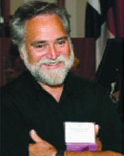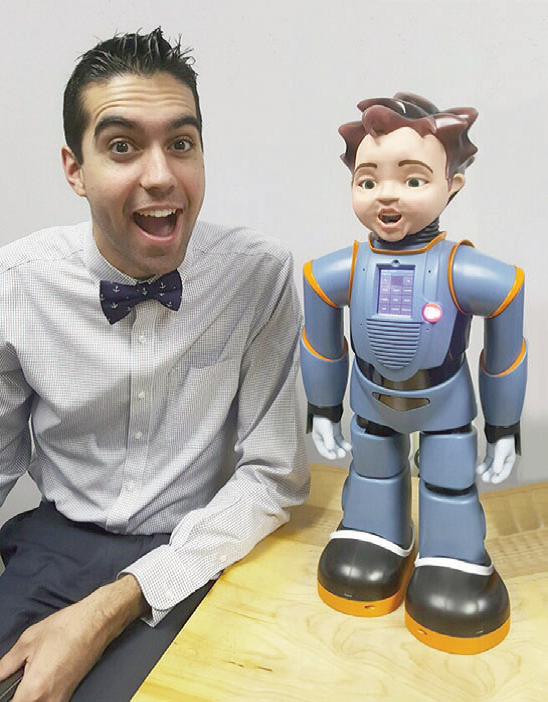ANCORA IMPARO BY RICK RADER, MD ■ EDITOR-IN-CHIEF
At the Orange Grove Center we are investigating the merits of using robots in teaching medical
students and family practice residents facial expression recognition.
Some diseases, conditions and disorders just don’t sound menacing. Cramps, flus, corns, styes and cysts. Even without knowing what they actually are, you could easily shrug your shoulders from the sound of their names.
But then there are others. Take Mad Cow Disease, Flesh Eating Bacteria, Walking Corpse Syndrome, Alien Hand Syndrome, Exploding Head Syndrome and Werewolf Syndrome. Without even knowing what they actually are, they sound menacing enough to have you head for the hills. The descriptions sound like something from a Stephen King novel.
In addition, even without the descriptive terms, the sheer length of some diseases would have most of us cowering. For instance, imagine your family doctor looking up from your chart and announcing that you have “Acrokeratoelastoidosis of Costa disease,” or “Bazopoulou Kyrkanidou syndrome.”
“Oh no, anything but “Der Kaloustian Jarudi Khoury syndrome.” Can’t even imagine how much the deductible for that one would be.
Some disease names come from the random body parts they afflict. Take “Diaphragmatic defect limb deficiency skull defect.” Not exactly a disease that would pack a room as a “break-out” session at a national medical conference.
I am fascinated by the names of diseases that relate to facial expressions. There is “Happy Face Syndrome,” “Baby Face Syndrome,” “Small Face Syndrome,” “Rigid Mask-Like Face Syndrome,” “Oral-Facial-Digital Syndrome,” and of course, “Whistling-face Syndrome.” My fascination with “face-related” disorders comes from my early studies in medical anthropology relating to the universality of facial expressions. Facial expressions are a form of nonverbal communication. They are a primary way of expressing social information between humans. Facial expressions are not unique to humans, they are also found in most other mammals and other animal species. The neat thing about human facial expressions is that they can be voluntary or involuntary, and the neural mechanisms responsible for controlling the expression differ in each case. Of particular interest is how facial expressions are used in sign language among the deaf.
In Caring for Patients from Different Cultures, Geri-Ann Galanti explains that “Raised eyebrows combined with a slightly forward head tilt indicate that what is being signed is a yes/no question. Lowered eyebrows are used for wh-word questions. Facial expression is also used in sign language to show adverbs and adjectives such as distance or size: an open mouth, squinted eyes, and tilted back head indicate something far while the mouth pulled to one side and the cheek held toward the shoulder indicate something close, and puffed cheeks mean very large.”
Floriano Martins hit it right on the mark with, “Faces always talk too much. One line and all their plans are revealed.”
The ability to “read faces” should be a standalone course in medical school, or at least part of the course in conducting the physical exam (if indeed they still teach that). The ability to “read” a patient’s face is as valuable a tool as “reading” a lab result; they both provide information, insight and a boost to one’s intuition. The “reading of facial expressions” is not limited to that of the “patient’s face.” The facial expression of the physician is vital too, as in the often needed “neutral facial expression” in discovering something during the physical examination of the patient.
The ten most common facial expressions that should be recognized by a physician include; confusion, shame, surprise, focus, exhaustion, seduction, anger, fear, sadness and happiness. In a recent research study (Emergency Medicine Journal), it was revealed that patients with serious heart and lung conditions don’t have the normal range of facial expressions. In particular, they seem to lack the ability to register surprise.
Having a flat affect, and an inability to offer or understand a cornucopia of facial expressions is one of the hallmarks of individuals with autism. This removes one of the most valuable clues in the examination of a patient with autism.
At the Orange Grove Center (where I thankfully am able to park my car in a reserved parking space, one of the perks of showing up for almost twenty-five years) we are investigating the merits of using robots in teaching medical students and family practice residents facial expression recognition. We are fortunate to be currently collaborating with the innovators at RoboKind, the developers of MILO, the world’s first humanoid robot that understands and communicates with individuals on the autism spectrum. MILO has the capacity to provide virtually every human facial expression.
We recently had our first insight into the value of using MILO as a teaching tool with family physicians during their residency training.
Dr. Andrew Keyes, a first-year family practice resident at the University of Tennessee’s College of Medicine, Chattanooga spent the morning at our Center as part of his introduction to community medicine. The requirement to become familiar with the community resources in caring for vulnerable and underserved patient populations was initiated by Dr. Mack Worthington, the progressive Chair of the Department of Family Medicine and the Director of the Family Practice Residency Program.
During Dr. Keyes’ time visiting Orange Grove, we met with AmyJo Schamens, our board certified behavior analyst who directs our research program using MILO in a variety of settings for individuals with autism. During this initial meeting we asked Dr. Keyes to both mimic MILO’s facial expressions and to identify the emotion that they might portray. We found that Dr. Keyes became totally engaged with the exercise and was able to quickly self-correct and modify his responses.
While we appreciate that using MILO to teach physicians how to recognize human autistic derived facial expressions is not a bromide or simple exercise, it certainly is a promising and valuable teaching tool. I am convinced that even MILO, who sees his role as an adjunct faculty member, and understands that exposure to working with patients with autism is mandatory, sees there is much to be gained by having a robot waiting in the wings.
Most reassuring of all was the unmistakable positive facial expression of Dr. Keyes which he emphasized with a universally recognizable thumbs up.•
ANCORA IMPARO
 In his 87th year, the artist Michelangelo (1475 -1564) is believed to have said “Ancora
In his 87th year, the artist Michelangelo (1475 -1564) is believed to have said “Ancora
imparo” (I am still learning). Hence, the name for my monthly observations and comments.
— Rick Rader, MD, Editor-in-Chief, EP Magazine Director, Morton J. Kent Habilitation Center
Orange Grove Center, Chattanooga, TN

